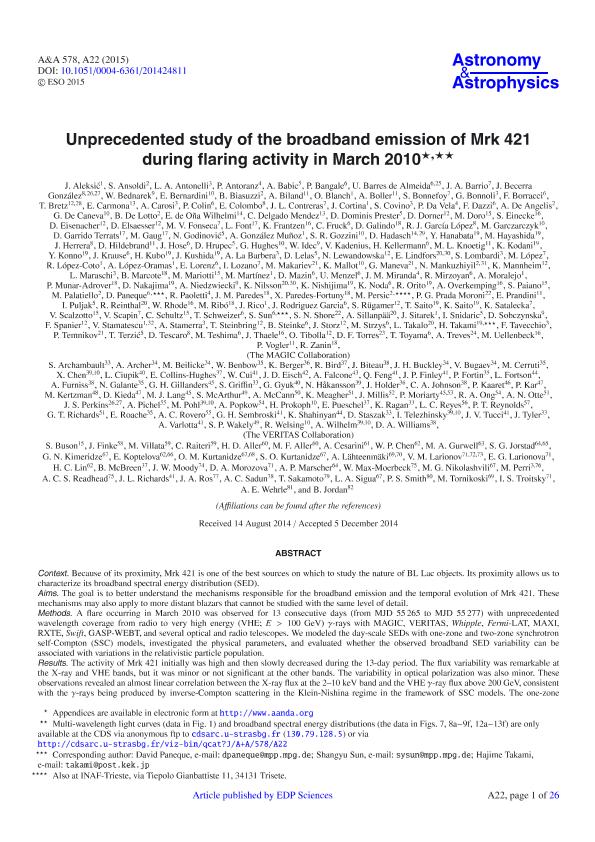Artículo
Unprecedented study of the broadband emission of Mrk 421 during flaring activity in March 2010
Aleksic, J.; Ansoldi, S.; Antonelli, L. A.; Antoranz, P.; Babic, A.; Bangale, P.; Barres de Almeida, U.; Barrio, J. A.; Becerra Gonzalez, J.; Bednarek, W.; Bernardini, E.; Biasuzzi, B.; Biland, A.; Blanch, O.; Boller, A.; Bonnefoy, S.; Bonnoli, G.; Borracci, F.; Bretz, T.; Carmona, E.; Carosi, A.; Colin, P.; Colombo, E.; Contreras, J. L.; Cortina, J.; Covino, S.; Da Vela, P.; Dazzi, F.; Pichel, Ana Carolina ; Rovero, Adrian Carlos
; Rovero, Adrian Carlos ; The Veritas Collaboration; The MAGIC Collaboration
; The Veritas Collaboration; The MAGIC Collaboration
 ; Rovero, Adrian Carlos
; Rovero, Adrian Carlos ; The Veritas Collaboration; The MAGIC Collaboration
; The Veritas Collaboration; The MAGIC Collaboration
Fecha de publicación:
06/2015
Editorial:
Edp Sciences
Revista:
Astronomy And Astrophysics
ISSN:
0004-6361
Idioma:
Inglés
Tipo de recurso:
Artículo publicado
Clasificación temática:
Resumen
Context. Because of its proximity, Mrk 421 is one of the best sources on which to study the nature of BL Lac objects. Its proximity allows us to characterize its broadband spectral energy distribution (SED).
Aims. The goal is to better understand the mechanisms responsible for the broadband emission and the temporal evolution of Mrk 421. These mechanisms may also apply to more distant blazars that cannot be studied with the same level of detail.
Methods. A flare occurring in March 2010 was observed for 13 consecutive days (from MJD 55 265 to MJD 55 277) with unprecedented wavelength coverage from radio to very high energy (VHE; E> 100 GeV) γ-rays with MAGIC, VERITAS, Whipple, Fermi-LAT, MAXI, RXTE, Swift, GASP-WEBT, and several optical and radio telescopes. We modeled the day-scale SEDs with one-zone and two-zone synchrotron self-Compton (SSC) models, investigated the physical parameters, and evaluated whether the observed broadband SED variability can be associated with variations in the relativistic particle population.
Results. The activity of Mrk 421 initially was high and then slowly decreased during the 13-day period. The flux variability was remarkable at the X-ray and VHE bands, but it was minor or not significant at the other bands. The variability in optical polarization was also minor. These observations revealed an almost linear correlation between the X-ray flux at the 2–10 keV band and the VHE γ-ray flux above 200 GeV, consistent with the γ-rays being produced by inverse-Compton scattering in the Klein-Nishina regime in the framework of SSC models. The one-zone SSC model can describe the SED of each day for the 13 consecutive days reasonably well, which once more shows the success of this standard theoretical scenario to describe the SEDs of VHE BL Lacs such as Mrk 421. This flaring activity is also very well described by a two-zone SSC model, where one zone is responsible for the quiescent emission, while the other smaller zone, which is spatially separated from the first, contributes to the daily variable emission occurring at X-rays and VHE γ-rays. The second blob is assumed to have a smaller volume and a narrow electron energy distribution with 3 × 104<γ< 6 × 105, where γ is the Lorentz factor of the electrons. Such a two-zone scenario would naturally lead to the correlated variability at the X-ray and VHE bands without variability at the optical/UV band, as well as to shorter timescales for the variability at the X-ray and VHE bands with respect to the variability at the other bands.
Conclusions. Both the one-zone and the two-zone SSC models can describe the daily SEDs via the variation of only four or five model parameters, under the hypothesis that the variability is associated mostly with the underlying particle population. This shows that the particle acceleration and cooling mechanism that produces the radiating particles might be the main mechanism responsible for the broadband SED variations during the flaring episodes in blazars. The two-zone SSC model provides a better agreement with the observed SED at the narrow peaks of the low- and high-energy bumps during the highest activity, although the reported one-zone SSC model could be further improved by varying the parameters related to the emitting region itself (δ, B and R), in addition to the parameters related to the particle population.
Palabras clave:
Bl Lacertae Objects
,
Gamma Rays
,
Agn
,
Non Thermal Radiation
Archivos asociados
Licencia
Identificadores
Colecciones
Articulos(IAFE)
Articulos de INST.DE ASTRONOMIA Y FISICA DEL ESPACIO(I)
Articulos de INST.DE ASTRONOMIA Y FISICA DEL ESPACIO(I)
Citación
Aleksic, J.; Ansoldi, S.; Antonelli, L. A.; Antoranz, P.; Babic, A.; et al.; Unprecedented study of the broadband emission of Mrk 421 during flaring activity in March 2010; Edp Sciences; Astronomy And Astrophysics; 578; 6-2015; A22,1-26
Compartir
Altmétricas



